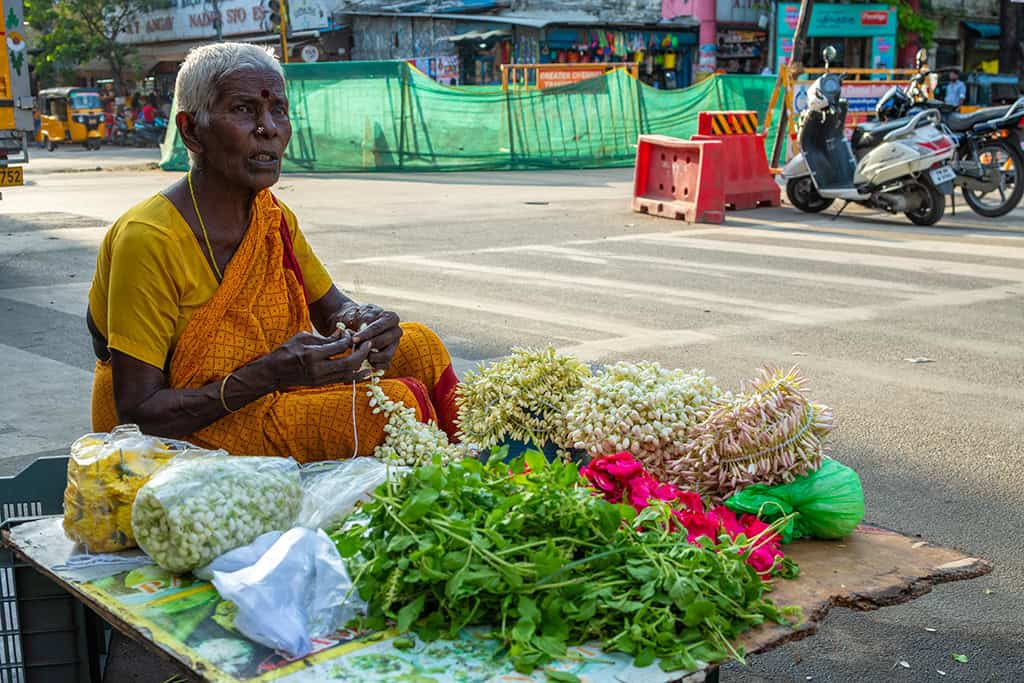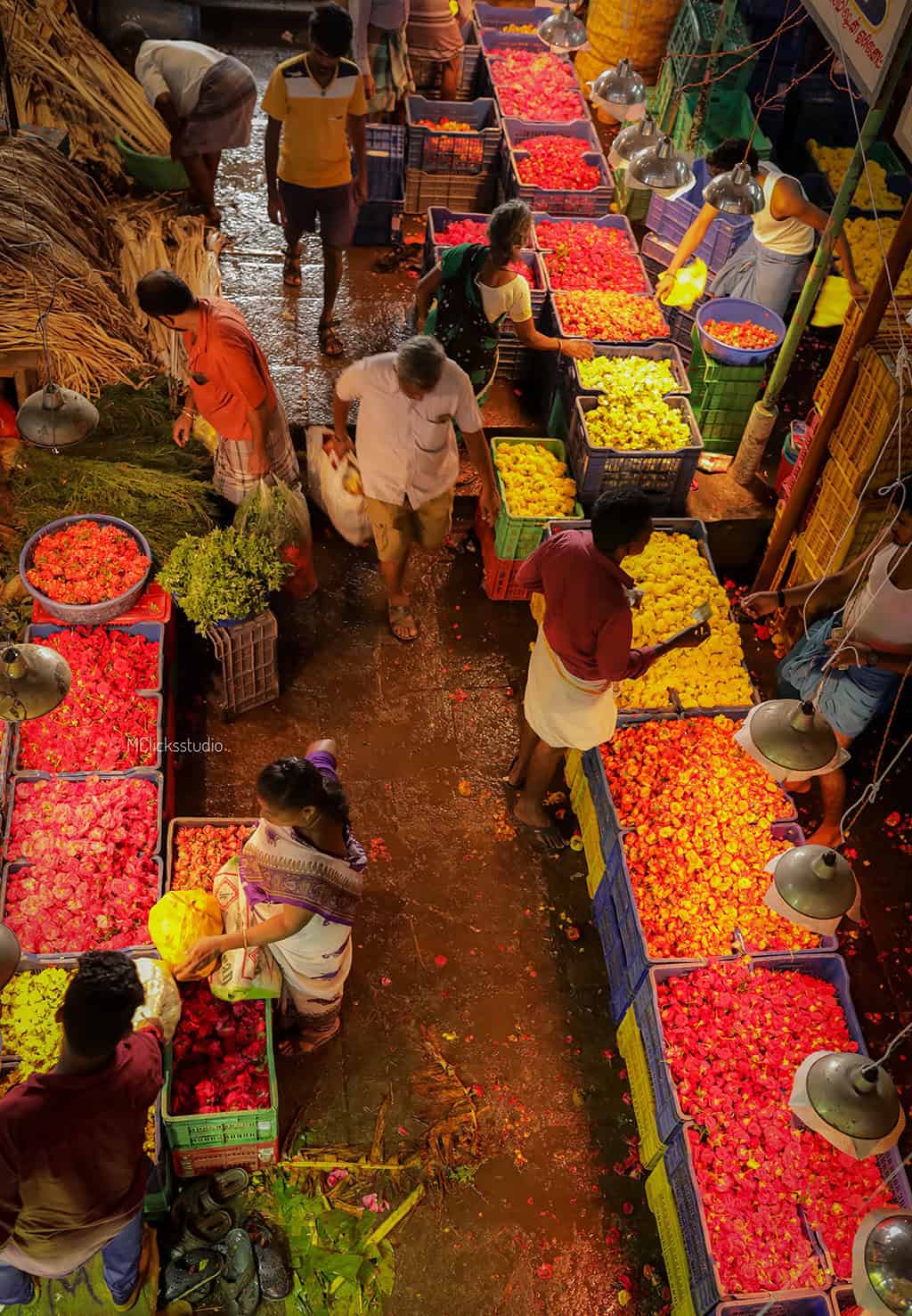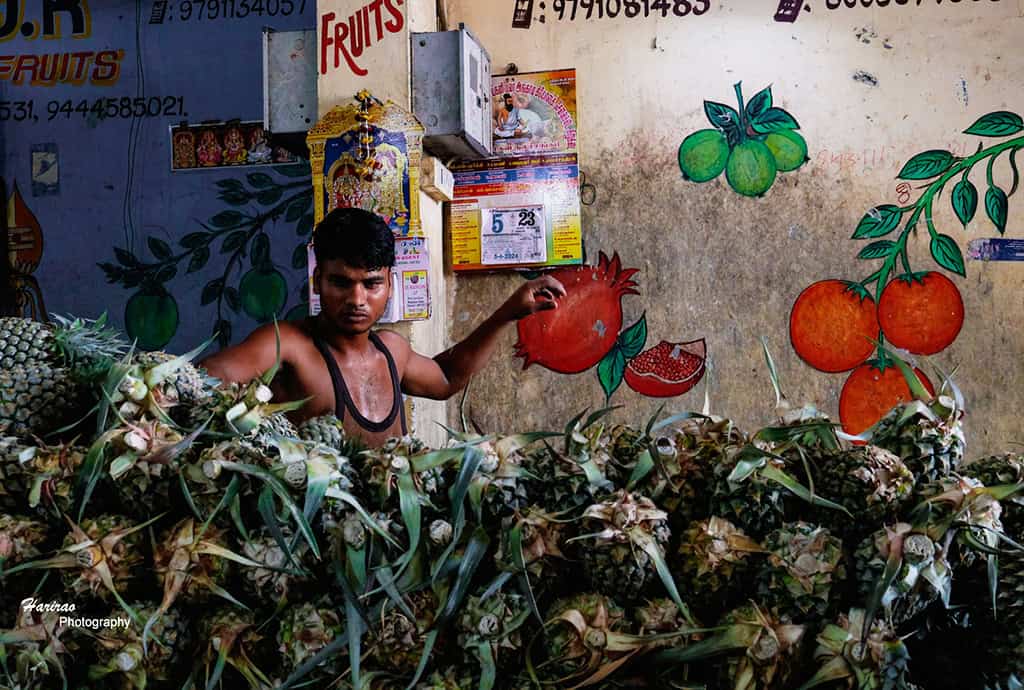The flowersellers of Mylapore
Wending my way through South Mada Street in Mylapore in the evening around 6 is like participating in a hurdles event but I find it rewarding at every turn. I have learnt to move expertly between the streaming vehicles, those parked haphazardly and criss-crossing folk like me. It’s a pleasure to see around me street vendors display their veggies and fruit in a panoply of colours and shapes, take in the wafting smell of freshly ground coffee powder walking past Sundaram Coffee shop, drool past Sangeetha, Vasanta Bhavan and Ratna Cafe, feel the vibes emanating from the Velleeswarar temple, and overall enjoy street life.


Pictures credit: Venkat and Roshini.
The other day I was on location to count how many women on the 200-250 metre stretch sell flowers. Sitting under the open skies, some pile up just a few mozhams of Malli (jasmine) on a piece of cardboard placed on crates and open shop. 1, 2, 3, 4…10, 11…16, 17,18…19, 20, 21, 22 and 23 ! You can well imagine the count on festival days ! Familiar with a couple of the women, I stop to talk to the dark-skinned and white-haired Tulukanathamman at the far end where South Mada Street meets RK Math Road. In her seventies, she’s been here a long, long time. I admire her positive attitude and disinterest for money. I try to probe into her beliefs, especially her faith in God. You see I love taking flowers on my temple visits, setting store by what the Gita (Cha. 9, v.26) and Tiruppavai (verse 5) say about devotion. So I am curious to know her side of the story. Translated from Tamil, she says when Andavan (the one who rules) provides for the lichen on the rock, what of me? She has seen it all, having sold flowers since when it was 12 mozhams a rupee. Today she sells a mozham for Rs 10, three for Rs 50, or whatever the market dictates. After my purchases, she never fails to wish me well.
While speaking to other flower-sellers closer home in Shenoy Nagar, Pushpa, sitting outside the Kanniamman temple, says it’s a no-brainer. ‘It all dawns because of Amman!’ Shanti delivers not just flowers but arugam pul, bilva leaves and tulsi for the puja at my doorstep in the late evenings. She raised her son selling flowers. He is now an employed graduate but still helps with her deliveries.
Sarasa, who foots it all over the neighbourhood and is in her seventies, confides in me about her heart ailment but is confident that the Maker will keep her literally on her feet in her lifetime.
To round off my story, I metroed it to Koyambedu, walked in the slush and rainwater through gigantic construction sites and reached the chaotic but totally functional wholesale flower market. And what did I see? Mountainous piles of flowers heaped under powerful bulbs being stored and sold in their kilos. Walking through long narrow passages, I am more than impressed, but suddenly feel lost and retrace my way out. What a huge but unclean marketplace! My salute to the city’s small vendors who brave it all and supply us our needs. In this case, flowers.
T.K. Srinivas Chari
srinivaschar@gmail.com
From Chaos to Charm: A Stroll Through Two Iconic Chennai Markets
There are markets… and then there is Koyambedu – a place so vast and lively, it could easily double up as its own republic. And then there’s the late, great Moore Market, which was Madras’s answer to Amazon long before Jeff Bezos sprouted his first beard.
Let’s begin with Koyambedu Wholesale Market Complex, fondly known to locals as KWMC – though nothing about it feels remotely abbreviated. It sprawls across a jaw-dropping 295 acres. That’s not a market. That’s practically a district.
I arrived at the market just after 7a.m., bleary-eyed but optimistic, only to find that the real action had begun hours earlier. Trucks honked, labourers hollered, and crates of carrots zoomed past me with all the urgency of a medical emergency. I soon realised that if you stand still for too long in Koyambedu, you may find yourself loaded onto a truck and sold as a particularly unenthusiastic yam.

Picture courtesy: Hari Sabanathan.
Despite the chaos – or perhaps because of it – Koyambedu is oddly mesmerising. There’s something deeply reassuring about watching fresh produce in glorious heaps, the kind that would make nutritionists swoon. Two blocks are dedicated entirely to vegetables, with one each for fruits and flowers. And somewhere in the ever-expanding master plan, textiles and food grains are slated to join the party. Because why not?

Picture courtesy: R. Hari.
Every day, 100,000 people throng the market. They come in waves – retailers at dawn, the public a little later, and I suspect some just come for the sheer thrill of dodging speeding trolleys. Amid the bustle, there’s bargaining of the most athletic kind. People haggle with the confidence of world leaders at trade summits. Even if you’re buying just two bananas, you are expected to bargain. Refusing to do so might raise suspicions that you’re from Bangalore.
Yet, for all its vibrance, wastage remains a concern. Spillage, poor handling, and flimsy packaging lead to tons of good produce going bad. But KWMC isn’t one to sit idle. They’ve installed a bio-methanation plant that turns 30 tonnes of waste into 2,500 units of electricity daily. Now that’s what I call a fruitful idea.
From the fresh to the forgotten, let’s take a detour to the dear departed Moore Market.
If Koyambedu is a feast for the senses, Moore Market was a buffet for the soul – the kind of place where you could buy a second-hand Shakespeare, a vintage gramophone record, a star tortoise, and a sari all in one stroll.
It opened in 1900, thanks to Lt. Col. Sir George Moore, President of the Madras Corporation who had the noble idea of relocating the erstwhile Loane Square market to a modern and structured bazaar. And what a bazaar it was! Indo-Saracenic architecture, 40,000 square feet, and a layout with outer and inner circles of shops – it looked like someone had asked an artist, “What if Hogwarts sold antiques and pets?”
Moore Market wasn’t just a shopping destination – it was an experience. It was Madras’s quirkiest address. If you were a book lover, you didn’t just browse – you were examined. Sellers knew their wares down to the ISBN and could find you an out-of-print copy of Moby Dick faster than you could say “Call me Ishmael.”
Every item came with a story, and a price that was delightfully negotiable. After a round of haggling (and possibly acquiring a live monkey), people would relax on open platforms to eat, chat, and marvel at their eccentric purchases.
But alas, all good things are eventually eyed by the Real Estate Department. In the 1980s, Madras needed space, and the Railways were lurking nearby. In 1985, a mysterious fire (read: “Oh no, how terribly convenient!”) gutted the market. Vendors were shifted to a new complex built on the filled-in Lily Pond, but the magic simply didn’t migrate. The new space lacked the old market’s spirit – and possibly its monkeys too.
Today, the Moore Market Complex near Chennai Central station is more of a railway terminal than a cultural bazaar. Its soul lingers in the pages of history books and the hearts of nostalgic Chennaiites.
Two Markets, Two Eras
Koyambedu and Moore Market represent two sides of Chennai’s ever-evolving heart. One is booming with produce, potential, and potatoes. The other is a memory wrapped in the scent of old paper and the sound of vintage records.
While one keeps the city fed, the other once kept it fascinated. Both, in their own ways, are love letters to a city that’s always juggling tradition and change, chaos and charm.
And if you ever find yourself dodging brinjals in Koyambedu or wistfully passing by Moore Market’s remnants, remember: in Chennai, a market is never just a place to shop. It’s where the city breathes, barters, and occasionally bursts into unexpected brilliance.
Author’s Note: Please bargain. And wear sturdy shoes.
– Priyanka Soman
I don’t know whether the author had seen Kothaval Chavadi where negotiating through the crowd and the filth was an art.